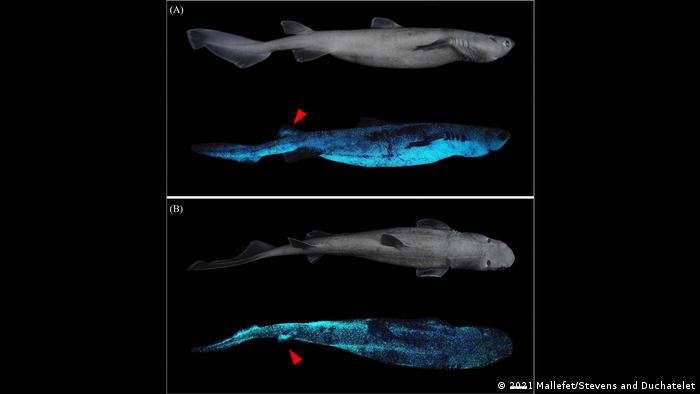The stone shark is the world’s largest luminous vertebrate known so far. It joins two other bioluminescent species previously found.
At the top of the seabed, between 200 and 1,000 meters deep, there is only a tiny amount of sunlight. This area known as twilight, is the habitat where the three species of sharks that are capable of emitting light in the dark have been discovered.
There, the six-foot-long stone shark, which glows in the dark and inhabits the depths of New Zealand’s waters, is the “world’s largest luminous vertebrate known to date,” according to a published scientific study. in the scientific journal Fronteras de las Ciencias Marinas.
Research confirms for the first time that this stone shark (Dalatias licha), as well as two other species (Etmopterus lucifer and Etmopterus granulosus) that inhabit the depths of New Zealand waters, and that were already known, are capable of producing a visible light to through biochemical reactions.
Specimens of these three species were captured in January 2020 during an expedition of the New Zealand Institute for Water and Atmosphere Research (NIWA) over the waters that cover the Chatham Rise ocean floor, a vast area that extends along 1,000 kilometers east of the oceanic country.
Jérôme Mallefet, lead author of the study and who first confirmed the existence of bioluminescent sharks in New Zealand, explained that the captured specimens produce a blue-green light that slowly glows and darkens.
“They glow in the dark, they don’t sparkle,” explained the Belgian scientist, who had the rare opportunity to study these characteristics in freshly caught specimens, in a NIWA statement.
How does its bioluminescence work?
Bioluminescent animals have organs, photophores, which are the ones that produce light. In most of them this process is controlled by the nervous system. But when the Belgian team of scientists studied the skin of captured sharks, where the photophores are found, they were surprised to find that they are the only animals whose light production is controlled by hormones.
Sharks, like other bioluminescent creatures, produce light to hunt their prey, to reproduce or when in groups, as well as to camouflage themselves in bright environments to protect themselves from predators, the statement added.
“It took us a whole year to figure out how to stimulate the organ of light because all the nerve transmitters failed,” says Mallefet. Until they realized that melatonin, the same hormone that induces sleep in humans, was the trigger for light in sharks: “Melatonin is what triggers the production of light and the hormone alpha-MSH stops it and it is a very slow process.”
Mallefer estimates that 57 of the 540 known species of sharks can produce bioluminescent light, most of them small in size that inhabit the so-called “twilight zone” of the sea, more than 200 meters deep.
“The existence of luminous organisms in this area (where the three species of sharks were found) makes it increasingly obvious that producing light at depth has an important role in structuring the enormous ecosystem of our planet”, according to this first study experimental.
Mallefet’s research, together with his colleague Laurent Duchatelet, from the Catholic University of Leuven, and Darren Stevens, from NIWA, could help to better understand the animals of the deep sea.

